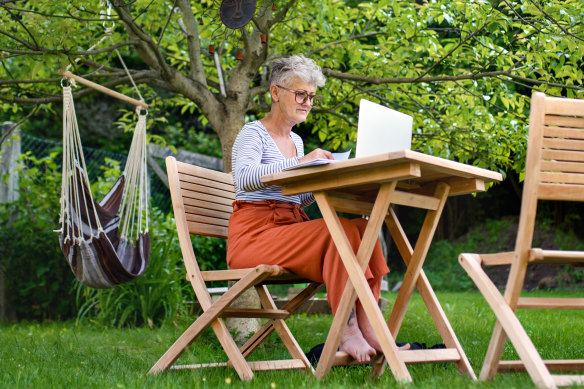Opinion
One group was working from home centuries ago. Here’s why it matters
Millie Muroi
Business ReporterWork, for me, is one of the greatest joys in life. It’s exhausting, and there are certainly days I’d rather be out in the sun playing soccer, but I love my job.
That’s not the case for everyone. But the opportunity to work comes with a lot of benefits: social and professional networks, empowerment and financial independence … the list goes on. It should be an opportunity accessible to all.

The pandemic has boosted the concept of working from home which has helped lift the proportion of women in work.Credit: Istock
While I’m not a caregiver (yet), it’s still a role more likely to be held by women than men. Because of this, one of the winners from the move towards flexible work in the past few years has been women.
But as Claudia Goldin, the most recent Nobel Prize winner in economics (and the first woman to win it solo) has pointed out, working from home is not a new phenomenon. In fact, women were doing it centuries before laptops, the internet and video calls shook up the way we work.
It’s not just a matter of women doing housework, because housework isn’t included when we measure the labour force: the number of people who work or are prepared to work.
Goldin, who was the first woman to be tenured in Harvard University’s economics department, has made many inroads into women’s labour market outcomes. One common misconception she has tackled is that as an economy develops, the share of women in the labour force grows with it. Instead, she showed women’s labour force participation rate tends to follow a U-shaped curve.
At first, when agriculture (especially poultry, dairy, rice, cotton or peanut farming) dominates the economy, and incomes are extremely low, there are a lot of women in the labour force. “They are sometimes paid labourers, but more often are unpaid workers on family farms and in household businesses,” Goldin says. At this point, we’re at the beginning of the U-curve.
Then as incomes rise, there is less immediate need for partnered women to work to support the family. This is called the “income effect”.
At the same time, technological advances mean many jobs previously done by women are replaced by tools, or by machines often used by men. Home-produced goods become less profitable compared with many factory-produced ones. The jobs that do increase are those in factories and big businesses. Some of these new jobs might still be in agriculture, but a lot of them are based away from the family home, and many are in manufacturing.

Claudia Goldin is the first woman to win the Nobel Prize in economics on her own, and to be tenured at Harvard University’s economics department.Credit: Josh Reynolds
Goldin also says there is often a stigma against married women working in a manual labour job in sectors such as construction, mining and transport. “The stigma is a simple message,” she says. “Only a husband who is lazy, indolent and entirely negligent of his family would allow his wife to do such labour.” The upshot of this is that women end up retreating into the home and giving up non-domestic work.
As the economy continues to develop, the level of education in the population increases, but mostly among men to begin with. This raises incomes, but not women’s productivity – relative to men’s – further reducing women’s labour force participation. Here we get to the bottom of the U-curve.
But as women’s access to education improves in later-stage economic development, there is more of a pull for them to join the labour force. That’s because secondary education in particular equips women to work in the growing proportion of office-based jobs. And these office-based jobs generally don’t come with the same social stigma attached for women.
At the same time, incomes continue to rise across the board, making work (relative to staying at home) more attractive. This is called the “substitution effect”: because people can earn more income for each hour worked, it encourages them to work more hours.
At this point, the substitution effect becomes stronger than the income effect, partly because the office-based jobs don’t carry the cost of stigma for women. As a result, women’s labour force participation starts climbing again towards the top of the U-curve.
Goldin says increased labour force participation is important because there is evidence that as women’s work moves outside the home and family, women tend to gain more freedom to make decisions and participate, politically, socially and even in their own homes.
While each country experiences the U-shaped curve differently, and along different time frames, it gives us insight into factors that encourage women into the labour force.
One is the ability to work flexibly. Working from home no longer has to mean only working for a family business. For a few years before COVID struck, the proportion of working women (the participation rate) hovered around 60 per cent to 61 per cent in Australia compared to about 71 per cent for men.
But women’s participation rate hit a high of 63.1 per cent in November 2023, and it has been hovering roughly around the 63 per cent mark for the past 12 months (while it’s stayed about the same for men).
Working from home has been especially beneficial for mothers. There is evidence from the US that a 10 per cent increase in working from home is associated with a nearly 1 per cent increase in mothers’ employment.
‘Only a husband who is lazy, indolent and entirely negligent of his family would allow his wife to do such labour.’
Claudia Goldin, a Nobel Prize winner in economics, describing the social stigma around women having manual labour jobs
Being able to work flexible hours, or to log on to a laptop from the living room, makes juggling unpaid jobs, such as childcare, with paid work more accessible.
The growth of parental leave in Australia has helped to shift some parenting responsibilities towards men. But women still took roughly 88 per cent of primary carer’s leave in 2020. That’s probably partly a reflection of continued stigma around men taking parental leave, but businesses have a big role to play, too.
Only 63 per cent of employers offered employer-funded paid parental leave in 2022, and only one-third of those offered it equally to men and women. That needs to change if we’re serious about giving women equal opportunity to enter and to remain in the workforce.
For now, the fact remains that women are more likely to be the primary caregivers. Until we see a social and workplace shift towards men and women sharing that responsibility more equally, childcare costs need to come down.
Not everyone will want to use a childcare service, and some already rely on friends and relatives. But making childcare affordable needs to be a priority.
Finally, we need to break down other financial barriers, some of which aren’t easily visible. At the end of the day, the decision to work, especially for women with kids, comes down to the pay-off. Remember the substitution effect: if you’re able to earn more, you’re more likely to be motivated to work.
As recently as 1966, many employers, including the Commonwealth public service, would not employ married women in permanent positions, and they expected a resignation if an existing female employee did marry. While we don’t have such explicit barriers in place for women today, there are still policies that make it a costly choice for women to work.
In a partnered household, family tax benefits often fall when a woman decides to work. Since women tend to be the lower-earning partner in a heterosexual partnership, it’s usually the woman who cuts back her hours or decides not to work. This poses a big obstacle for women with families to join the workforce.
We’ve made big strides when it comes to women’s labour force participation, but we need to kick more goals and preserve gains from recent developments including flexible work if we want to stay at the top of the U-curve.
Ross Gittins is on leave.
The Business Briefing newsletter delivers major stories, exclusive coverage and expert opinion. Sign up to get it every weekday morning.